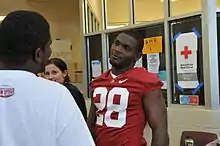Sport communication
Sports communication is an aspect of communication studies which specializes in the study of communication in a sports setting. It can encompass the study of interpersonal and organizational communication (both verbal and non-verbal) between participants within a particular sport (e.g. players, coaches, managers, referees, trainers and physiotherapists, and governing bodies); communication between sports participants, fans, and the media; and the way that sports are represented and communicated in the media. Sports communication is something that happens at different levels ranging from preschool to college level. It's not restricted to professionals. It happens constantly and works best with people that are willing to work well as a team. If everyone is on board and has positive thoughts and communication, it becomes very dismantling to the person receiving the message. It is not only for positive talk, though, because negative sports communication happens all the time.[1]
Personal and Organizational Communication in Sport could involve intrapersonal, interpersonal, and small-group communication in sport, while organizational communication research could include intra- and interorganizational communication in sport.[2]
Careers
- Agents and Business Managers of Artists, Performers, and Athletes.
- Communications Teachers, Postsecondary.
- Entertainers and Performers, Sports and Related Workers, All Other.
- Public Relations Specialists.
- Radio and Television Announcers.
- Reporters and Correspondents.[3]

Opportunities
Sports creates a context for positive communication and pro-social behaviors that often occur off of the field or court. For example, many athletes speak in public to children or act as motivational speakers. In tough situations, such as the aftermath of a natural disasters, well known athletes can lift the moral of an affected community. Sports writer Lars Anderson wrote in his book The Storm and The Tide about how sports helped bring a town together after a disastrous tornado. Also, the situation and community coming together affected the college sports team at The University of Alabama. Andrew C. Billings, professor at The University of Alabama, discusses how sports have the ability to start meaningful conversations https://www.youtube.com/watch?v=HU8R0bZzqfg. Sports communication theories allow for the prediction of many facets of communication such as gender, race, identity, culture, and politics.[4]
Sports communication varies vastly between individual sports and plays an important role in the success of teams and organizations. A good example of sports communication and its effects on players, organizations and media was the well-documented conflict involving two players for the Miami Dolphins. Inappropriate, discriminatory, and abusive interactions between Richie Incognito and Jonathan Martin lead to the release of Richie from the team, organizational issues, and an abundance of media coverage both negative and positive. Another example of sport communication is the recent "deflategate" scandal involving the New England Patriots apparently deflating the footballs during half-time of the AFC Championship game against the Indianapolis Colts. Head coach Bill Belichick claims that any wrongdoing was done by the teams equipment manager and ball boy, and no communication had occurred between them two at any point in the game. This reflects sports communication because it is an example of a lack of communication between an inferior member of an organization and the head coach, which eventually led to a wide spread and highly publicized scandal which could've jeopardized the Patriots participation in the Super Bowl.
References
- Peddersen, Miloch, and Laucella (2007) p. 76
- Abeza, Gashaw; O'Riley, Norm; Nadeau, John (September 1, 2014). "Sport Communication: A Multidimensional Assessment of the Field's Development". International Journal of Sport Communication. 7 (3): 289–316. doi:10.1123/IJSC.2014-0034.
- "Careers for Sports CommunicationMajors". www.mymajors.com. Retrieved 2020-03-12.
- "Communication and Sport: Surveying the Field". Sage.
- Pedersen, Paul; Miloch, Kimberly S.; Laucella, Pamela C. (2007). Strategic Sport Communication. Human Kinetics. ISBN 0-7360-6524-5
- Abeza, Gashaw; O'Riley, Norm; Nadeau, John (September 1, 2014). "Sport Communication: A Multidimensional Assessment of the Field's Development". International Journal of Sport Communication.
- Further reading
- Brown, Robert S. (2003). Case Studies in Sport Communication. Greenwood Publishing Group. ISBN 0-275-97530-4
- Pedersen, Paul; Parks, Janet; Quarterman, Jerome; Thibault, Lucie (2010). Contemporary Sport Management 4th edition. Human Kinetics. ISBN 0-7360-8167-4
- Weinberg, Robert S. and Goujiel (2010). Foundations of Sport and Exercise Psychology, 5th edition. Human Kinetics. ISBN 0-7360-8323-5
External links
- Effective Communication in Sports on livestrong.com